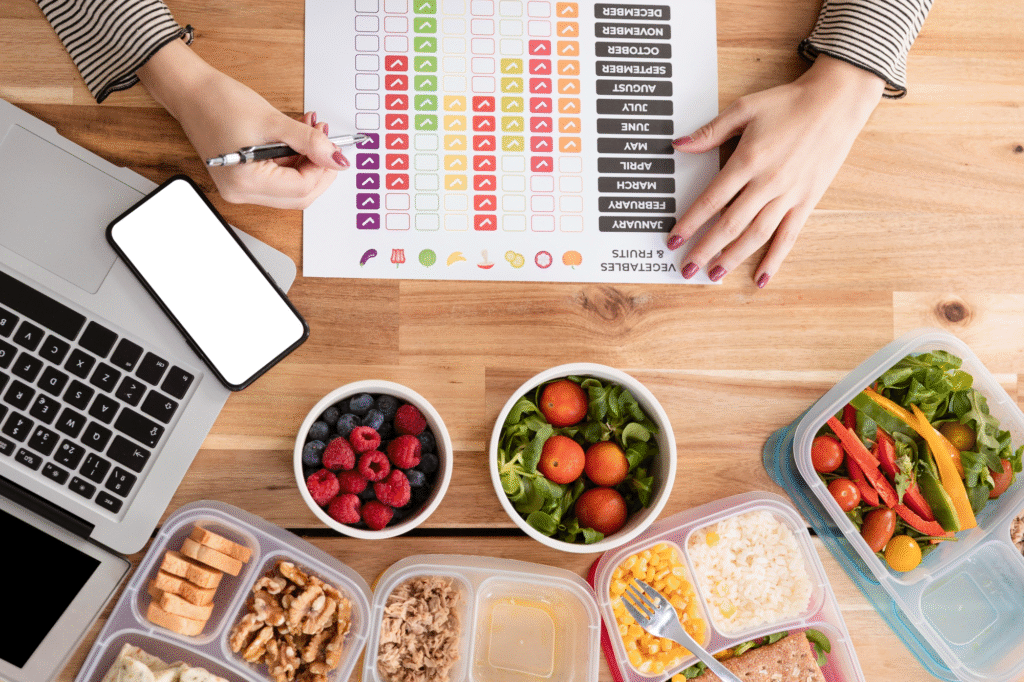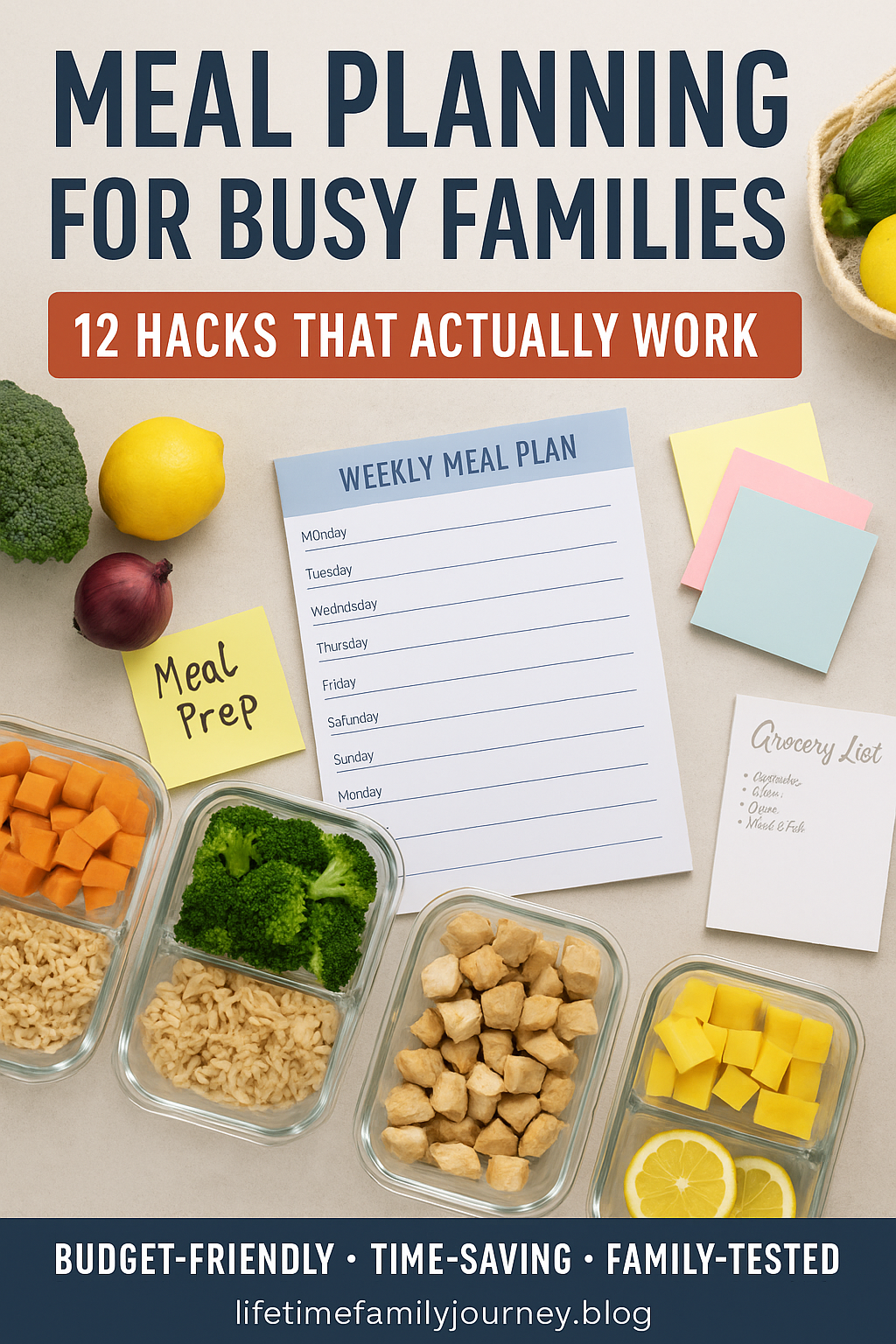Meal Planning for Busy Families: 12 Proven Secrets

Let me paint you a picture: It’s 5:30 PM on a Tuesday. You just walked through the door after picking up kids from three different activities, your phone is buzzing with work emails, and someone’s already asking “What’s for dinner?” You open the fridge hoping for inspiration but find only expired yogurt, random condiments, and a questionable leftover from last weekend.
Sound familiar?
After two decades of marriage and wrangling six kids through countless dinner disasters, I’ve learned that meal planning for busy families isn’t just helpful—it’s survival. When you’re feeding a houseful of people with different schedules, preferences, and appetites, throwing together random meals becomes expensive, stressful, and downright exhausting.
The good news? You don’t need to be a Pinterest-perfect parent or have hours of free time to master meal planning for busy families. I’ve discovered twelve secrets that actually work for real families with real chaos. These aren’t theoretical tips from someone who’s never dealt with a toddler meltdown at dinner time—they’re battle-tested solutions from the trenches of family life.
When you implement effective meal planning for busy families, you’re not just solving tonight’s dinner problem—you’re creating a sustainable system that works week after week.
Why Meal Planning for Busy Families Changes Everything
Before we dive into the strategies, let’s talk about why meal planning for busy families matters. Most Americans spend between 30-43% of their food dollars eating out, with more money being spent in restaurants than grocery stores for the first time in American history. When you’re constantly scrambling for dinner solutions, those drive-through runs add up fast.
But it’s not just about money. Meal planning for busy families transforms your entire week by:
According to MyPlate.gov, planning meals helps you save money by using what you already have and avoiding impulse purchases. When you prepare ahead of time you don’t need that last-minute stop through the drive-thru line. Shopping with a grocery list helps reduce impulse buys at the store.
The reality is that meal planning for busy families becomes essential when you’re juggling multiple schedules, dietary preferences, and budget constraints all at once. Additional benefits include:
- Eliminating daily decision fatigue (no more 5 PM panic)
- Reducing grocery store trips from multiple weekly visits to one focused shop
- Creating predictable family routines that kids can count on
- Improving nutrition since you’re not relying on processed convenience foods
- Saving actual time despite the upfront investment
Strategy #1: Start With Your Calendar, Not Your Cravings 📅
Here’s where most families go wrong: they plan meals based on what sounds good, not what fits their actual life. As a dad who’s been through every conceivable schedule disaster, I learned this lesson the hard way when I tried following elaborate meal planning systems that looked perfect on paper but failed in real family chaos.
Your weekly meal planning for busy families should start with these questions:
- Which nights have sports practice or late meetings?
- When do you have the most time to cook?
- Are there evenings when you’ll be home late?
- Which days could you handle more complex recipes?
Color-coding your days can make this easier: green for days when you have time for elaborate meals, yellow for medium-energy cooking, and red for nights when you need something quick or pre-made.
This strategic approach to meal planning for busy families ensures you’re not trying to cook a complicated meal on your most chaotic day.
Pro tip from our household: Sunday nights are always slow cooker meals because Monday mornings are chaos. Thursday is leftover night because everyone’s tired, and Friday is pizza night because we’ve earned it. This approach aligns with what experts at Harvard’s Nutrition Source recommend about matching meal complexity to your available time and energy.
Strategy #2: Master the Art of Strategic Grocery Shopping 🛒
Efficient grocery shopping for families starts before you leave the house. After countless trips where I forgot key ingredients or bought things we already had, I developed a system that actually works and mirrors advice from financial experts at Ramsey Solutions about strategic shopping.
The Three-Step Shopping Method:
- Inventory first: Check your pantry, fridge, and freezer before planning anything
- Plan around sales: Prioritize what’s on sale and switch out ingredients when you find better deals
- List by store section: Organize your list so you’re not backtracking through the store
One game-changer: Shop on weekdays instead of weekends when possible. Stores are less crowded, items are more likely to be in stock, and you won’t need as many substitutions. You might also want to read more about easy weeknight dinners for large families for additional meal ideas that work with this shopping strategy.
Strategy #3: Embrace the Power of Flexible Meal Templates
Instead of following rigid recipes every night, develop meal templates that can adapt to what you have on hand. This is crucial for busy family meal prep because life happens, and you need backup plans. Check out our family-friendly recipes and tips for more template ideas that work with various dietary needs.
My go-to templates:
- Protein + Roasted Veggie + Grain: Chicken thighs + Brussels sprouts + rice
- One-Pan Wonders: Sheet pan meals with everything cooked together
- Slow Cooker Sets: Dump everything in the morning, dinner’s ready when you get home
- Build-Your-Own Bowls: Base ingredients that everyone can customize
These templates take the decision-making out of cooking while giving you flexibility when ingredients change or schedules shift. The beauty of templates in meal planning for busy families is that they adapt to whatever you have available while still providing structure.
Strategy #4: Cook Once, Eat Multiple Times (But Make It Interesting) 🔄
Repurposing leftovers is key to budget-friendly meal planning, but palate fatigue is real—people get tired of eating the same thing repeatedly. The trick is transforming leftovers into completely different meals. For more ideas on this approach, explore our guide on creative ways to repurpose leftovers into new meals.
Leftover transformation examples:
- Sunday’s roast chicken becomes Monday’s chicken salad wraps
- Tuesday’s taco meat turns into Wednesday’s loaded quesadillas
- Thursday’s rice gets mixed into Friday’s fried rice with eggs and vegetables
Double-batch strategically: When making soup, chili, or casseroles, make enough for two meals but freeze half immediately. Future you will thank present you.
This approach to meal planning for busy families means you’re essentially cooking twice but only doing the work once—a huge time-saver for hectic weeks.
Strategy #5: Get Everyone Involved (Yes, Even the Little Ones) 👨👩👧👦
One of the biggest meal planning mistakes is trying to do everything yourself. When kids help pick recipes and see pictures of what they’ll be eating, they’re more excited about meals and more likely to actually eat them. This connects to broader principles about building healthy family routines that actually work – involving everyone creates buy-in.
Age-appropriate involvement:
- Ages 3-6: Let them choose between two vegetable options or pick the fruit for the week
- Ages 7-12: They can help with grocery lists and simple meal prep tasks
- Teenagers: Give them ownership of one meal per week, including planning and cooking
My middle school math teacher wife always says the same thing about homework and meal planning: kids are more invested when they have ownership in the process.
Strategy #6: Build Your “Emergency Meal” Arsenal 🚨
Every family needs backup meals for when life goes sideways. These aren’t fancy, but they’re lifesavers when someone gets sick, practices run late, or you just can’t deal with cooking. Our meal planning for big families guide covers this concept in more detail for larger households.
Our emergency rotation:
- Bean and cheese quesadillas (5 minutes)
- Scrambled eggs and toast
- Pasta with butter and parmesan
- Grilled cheese and soup
- Yes, sometimes it’s cereal for dinner
Having backup meals prevents the last-minute drive-through runs that can destroy your budget and routine. Stock ingredients for these meals so they’re always available.
Emergency meals are a crucial component of any successful meal planning for busy families system—they’re your safety net when everything else falls apart.
Strategy #7: Prep Smart, Not Hard ⏰
Meal prep doesn’t mean spending your entire Sunday in the kitchen. Strategic prep focuses on the time-consuming tasks that slow you down during busy weeknights.
High-impact prep tasks:
- Wash and chop vegetables when you get home from shopping
- Cook grains and pasta in batches
- Brown ground meat for multiple uses
- Prepare marinades for quick weeknight proteins
While foods are cooking, multitask by chopping vegetables, washing salad greens, or portioning snacks for the week. Thirty minutes of focused prep can save hours during the week.
Smart meal planning for busy families includes this kind of efficient prep work that maximizes your time investment.
Strategy #8: Theme Nights Make Planning Easier 🎭
Dedicating one night a week to themed meals can transport your family around the world while making planning decisions easier. When you have structure, you eliminate the daily “what should we eat” decision.
Theme night ideas:
- Meatless Monday: Vegetarian options
- Taco Tuesday: Mexican-inspired meals
- One-Pot Wednesday: Minimal cleanup dinners
- Throwback Thursday: Family comfort food favorites
- Friday Night Takeout: Homemade versions of restaurant favorites
Themes give you a framework while still allowing creativity within each category. Many successful meal planning for busy families approaches use themes because they eliminate decision fatigue while maintaining variety.
Strategy #9: Master Quick-Cooking Proteins 🥩
Protein often takes the longest to cook, so having quick-cooking options ready is essential for busy family meal prep. Focus on proteins that cook in 20 minutes or less.
Quick protein options:
- Chicken thighs (cook faster than breasts and stay more tender)
- Ground turkey or beef (cooks in 10-15 minutes)
- Fish fillets (most cook in under 15 minutes)
- Eggs (always quick and versatile)
- Pre-cooked rotisserie chicken for instant meals
A $5 rotisserie chicken from Costco can provide protein for multiple meals throughout the week. Shred it immediately and use in different preparations.
This strategy exemplifies efficient grocery shopping for families—one purchase that serves multiple purposes in your meal planning for busy families routine.
Strategy #10: Streamline Your Shopping with Technology 📱
Modern meal planning for busy families can leverage technology to reduce mental load and save time. After years of handwritten lists and forgotten items, I’ve found a few digital tools that actually help.
Useful tech solutions:
- Shared family grocery apps where anyone can add needed items
- Store pickup or delivery services for time-pressed weeks
- Recipe apps that can generate shopping lists automatically
- Voice assistants for adding items to lists when you notice you’re running low
The key is finding simple solutions that reduce work, not create more of it. Technology should support your meal planning for busy families efforts, not complicate them.
Strategy #11: Build Buffer Time Into Your Plans ⏱️
Perfect meal plans look great on paper, but real life includes sick kids, overtime at work, and unexpected events. Meal planning should be flexible enough to accommodate your family’s actual schedule, not an idealized version of it.
Buffer strategies:
- Plan only 5-6 meals for a 7-day week
- Keep one night completely open for leftovers or emergency meals
- Have ingredients for 2-3 super quick meals always on hand
- Don’t plan complicated meals on days when schedules are already packed
Flexibility isn’t failure—it’s smart planning that acknowledges how families actually live.
Strategy #12: Start Small and Build Your System 🌱
Start by planning meals for just your busiest, most stressful nights rather than trying to plan an entire week immediately. Trying to overhaul everything at once usually leads to giving up when life gets overwhelming.
Building your system gradually:
- Week 1: Plan just 3 meals
- Week 2: Add breakfast planning
- Week 3: Include lunch prep
- Week 4: Refine your grocery shopping process
After a month, you’ll have a routine that feels natural rather than forced.
The Reality Check: Making It Work Long-Term
Let me be honest—some weeks, meal planning falls apart. Kids get sick, work explodes, or life happens. That’s normal and okay. The goal isn’t perfection; it’s having a system that works most of the time and makes your life easier overall.
After feeding six kids for years, I’ve learned that successful meal planning for busy families adapts to your family’s reality, not some Instagram-perfect ideal. Some weeks we eat a lot of quesadillas and rotisserie chicken. Some weeks we nail every planned meal. Both are fine.
Budget-Friendly Meal Planning That Actually Saves Money 💰
Let’s talk numbers because this matters to real families. Effective budget-friendly meal planning can save families around $500 per month by reducing takeout orders and preventing food waste. For families looking to maximize savings, check out our smart shopping for a busy and large family guide.
Money-saving strategies that work:
- Shop your pantry first before planning new meals
- Buy versatile ingredients that work in multiple recipes
- Choose generic brands—even top chefs use them because the quality is often similar to name brands
- Plan for planned leftovers, not accidental ones
The upfront time investment pays off quickly when you’re not making emergency grocery runs or ordering pizza because you have no dinner plan.
Your Weekly Planning Routine
Once you’re ready to implement these strategies, here’s a simple weekly routine that takes about 30 minutes:
- Check your calendar for the coming week (5 minutes)
- Inventory what you have in pantry, fridge, and freezer (5 minutes)
- Plan 5-6 meals using your templates and themes (10 minutes)
- Create your grocery list organized by store section (5 minutes)
- Do basic prep when you return from shopping (5 minutes)
That’s it. No complicated spreadsheets or elaborate systems—just a simple routine that fits into real family life.
Common Meal Planning Mistakes to Avoid 🚫
- Planning too many complicated meals for busy weeks
- Not accounting for your family’s actual schedule when choosing recipes
- Trying to please everyone with every meal instead of having options
- Not having backup plans when the original plan fails
- Making it too complicated and then giving up when it becomes stressful
Getting Started This Week
Ready to try meal planning for busy families? Start with these three simple steps:
- Choose your planning day: Pick one day each week when you’ll spend 30 minutes planning
- Select your easiest week: Don’t start during the busiest week of the year
- Plan just 4 meals: Keep it simple and build confidence
Remember, the goal is creating a system that reduces stress, not adds to it. Your meal planning should make dinner time easier, not turn it into another complicated project.
The Bottom Line
Meal planning for busy families isn’t about being perfect—it’s about being prepared. When you have a plan, you spend less time stressed about dinner, less money on takeout, and more time actually enjoying meals with your family.
After years of trial and error (and plenty of failed dinner experiments), these twelve strategies have transformed how our family approaches meals. Some weeks are smoother than others, but having a system means we’re never completely lost when dinner time rolls around.
Your family’s meal planning for busy families system might look different from ours, and that’s perfectly fine. The key is finding strategies that work for your schedule, your budget, and your family’s preferences. Start with one or two strategies that feel manageable, then build from there.
Because at the end of the day, the best meal plan is the one you’ll actually follow. Keep it simple, stay flexible, and remember that feeding your family doesn’t have to be perfect—it just has to work.
🌐 Explore More from My Family of Blogs
If you found this article helpful, you might also enjoy what I’m sharing across my other platforms. Each one is designed to uplift, equip, and inspire families in real, practical ways:
🏠 Mountains Will Move
Faith-based encouragement for everyday families. I dive into prayer, parenting, purpose, and pressing through life’s hardest seasons with Jesus at the center.
👉 Visit Mountains Will Move »
🔎 Everyday Exposed
My no-filter truth hub—where I tackle myths, challenge misleading narratives, and bring clarity to the conversations that matter most.
👉 Visit Everyday Exposed »
Whether you’re diving deeper into pet care, faith, or uncovering truth in today’s noisy world, I hope you’ll journey with me.
Thank you for being part of the journey. God Bless you and your family. 🙏


